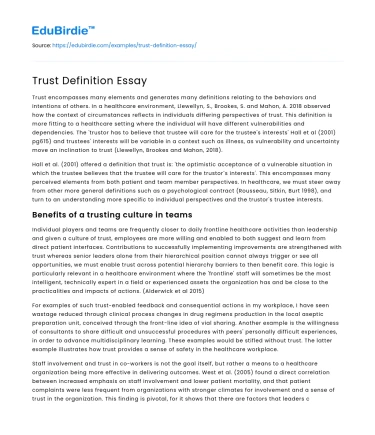Trust encompasses many elements and generates many definitions relating to the behaviors and intentions of others. In a healthcare environment, Llewellyn, S., Brookes, S. and Mahon, A. 2018 observed how the context of circumstances reflects in individuals differing perspectives of trust. This definition is more fitting to a healthcare setting where the individual will have different vulnerabilities and dependencies. The 'trustor has to believe that trustee will care for the trustee's interests' Hall et al (2001) pg615) and trustees' interests will be variable in a context such as illness, as vulnerability and uncertainty move an inclination to trust (Llewellyn, Brookes and Mahon, 2018).
Hall et al. (2001) offered a definition that trust is: 'the optimistic acceptance of a vulnerable situation in which the trustee believes that the trustee will care for the trustor`s interests'. This encompasses many perceived elements from both patient and team member perspectives. In healthcare, we must steer away from other more general definitions such as a psychological contract (Rousseau, Sitkin, Burt 1998), and turn to an understanding more specific to individual perspectives and the trustor's trustee interests.
Save your time!
We can take care of your essay
- Proper editing and formatting
- Free revision, title page, and bibliography
- Flexible prices and money-back guarantee
Benefits of a trusting culture in teams
Individual players and teams are frequently closer to daily frontline healthcare activities than leadership and given a culture of trust, employees are more willing and enabled to both suggest and learn from direct patient interfaces. Contributions to successfully implementing improvements are strengthened with trust whereas senior leaders alone from their hierarchical position cannot always trigger or see all opportunities, we must enable trust across potential hierarchy barriers to then benefit care. This logic is particularly relevant in a healthcare environment where the 'frontline' staff will sometimes be the most intelligent, technically expert in a field or experienced assets the organization has and be close to the practicalities and impacts of actions. (Alderwick et al 2015)
For examples of such trust-enabled feedback and consequential actions in my workplace, I have seen wastage reduced through clinical process changes in drug regimens production in the local aseptic preparation unit, conceived through the front-line idea of vial sharing. Another example is the willingness of consultants to share difficult and unsuccessful procedures with peers' personally difficult experiences, in order to advance multidisciplinary learning. These examples would be stifled without trust. The latter example illustrates how trust provides a sense of safety in the healthcare workplace.
Staff involvement and trust in co-workers is not the goal itself, but rather a means to a healthcare organization being more effective in delivering outcomes. West et al. (2005) found a direct correlation between increased emphasis on staff involvement and lower patient mortality, and that patient complaints were less frequent from organizations with stronger climates for involvement and a sense of trust in the organization. This finding is pivotal, for it shows that there are factors that leaders can shape (i.e. staff involvement) that influence and develop such a concept as trust.






 Stuck on your essay?
Stuck on your essay?

